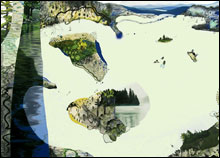 The conundrum, as Sandy Litchfield boiled it down for me recently, was that we’ve all seen stunning sunsets in nature, but what painting has evoked that same sensation? How could she render landscapes in a way that captures the spark and the surprise she experiences while tromping through the patchwork of nature preserves near her home in Amherst, or the hills around her family’s summer home in the Adirondacks?
The conundrum, as Sandy Litchfield boiled it down for me recently, was that we’ve all seen stunning sunsets in nature, but what painting has evoked that same sensation? How could she render landscapes in a way that captures the spark and the surprise she experiences while tromping through the patchwork of nature preserves near her home in Amherst, or the hills around her family’s summer home in the Adirondacks?
In a mostly unconscious way, the 39-year-old is wrestling with the ghosts of Thomas Cole and the 19th-century Hudson River School, who hunted some of the very territories she travels for subjects to paint and who still loom large in American art with their landscapes celebrating the nation’s natural wealth and its westward expansion while also, already, beginning to lament the taming of its wilds.
“Surrounding Practice” at Bernard Toale Gallery elaborates on the answer that Litchfield came to while earning her MFA degree at UMass-Amherst in 2003 and that was represented in her works in the DeCordova Museum Annual Exhibition the following year. At first she tried painting conventional landscapes, but they weren’t quite right. Now she frequently ventures outdoors, but she doesn’t sketch on site. Instead, she snaps digital photographs and collects leaves, rocks, and twigs to kindle inspiration at home. Over the nest 24 hours, she jots down her impressions. She often develops these into small watercolors, like the 16 hung in the Toale main gallery, in which the landscape is abstracted into flowing shapes that find their own boundaries, unmindful of the edge of the page. They feel like an explorer’s notations. And these, in turn, beget Litchfield’s full-scale paintings in oil, acrylic, and ink.
Inspired by the summer home on Blue Mountain Lake, which she’s visited all her life, the six-by-eight-foot canvas Summer Reunion (2006) shows a pale-green lake speckled with islands and ringed by a wooded coast. An island in the northwest is built atop a thin gray-brown wash that defines the land mass; wavy lines along the island’s bottom edge delineate the shore; forested areas are jotted in as round dashes. One swath is built up into an impasto of green and yellow dabs, circles, and wiggly lines, the thickness of the paint suggesting more dense topography as well as greater psychological importance.
The 2004 work from which the exhibit borrows its title is a 20-foot-long painting affixed directly to the gallery wall starting in the lobby and continuing around a corner into the main gallery. Your eye follows the black and gray path winding through woods, a boulder field, clover, pebbles, marshy spots. Litchfield switches smoothly between runny, watery paint and impasto, between quick diagrammatic passages rendered like symbols on a map and blurry representational images of evergreens reflected in the lake.
ADVERTISEMENT
 |
Occasionally she seems to lose her concentration, plopping down silhouetted hikers or tiny boats or birds rendered as V shapes, symbols low on ambiguity that halt thinking instead of opening up new vistas in the mind. But when she’s on, her style mimics the way we remember our travels — the mapped path, rough parts where we had to keep our eyes glued to the trail, spots where we stopped to take in scenic views. The style draws some of its magic from the simplicity and wonder of children’s drawings. And borrowing an idea from traditional Japanese scrolls in which scenes of a journey unfold before you with each turn of the scroll, she gets you to feel for a moment as if you were making the hike yourself as you walk from vignette to vignette, not knowing what you’ll find around the next bend.
About half of Michael Lynch’s 25 photographs at Gallery Kayafas are devoted to pure landscapes (you can almost hear the summer breeze rustling the dune grass in one sensuous 2002 triptych), but the star of the show is his “Alphabet Series” from 1999. The 42-year-old South Ender photographed hunky male friends clad only in form-fitting boxer briefs and bent into the shapes of the letters of the alphabet. It’s kind of endearing that he adopts such a flimsy excuse to take photographs of scantily clad men frolicking among the dunes and tide pools of Provincetown.
The Letter N shows the legs of two men facing the same direction and standing quite close together. The N is formed when the fellow in front strides forward, leaving his trailing foot between the feet of his partner, who has his legs together. In The Letter B, you spy two men lying on their sides, resting their heads on each other’s shoulders. The man on the right reaches his arm around to lay his fist on the back of the other’s skull. Their pose suggests they’re frozen in an embrace, maybe wrestling, maybe consoling each other.